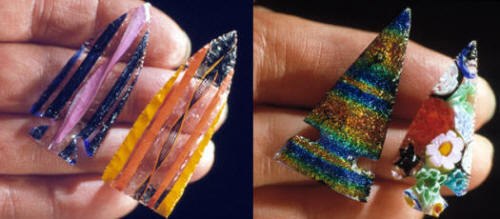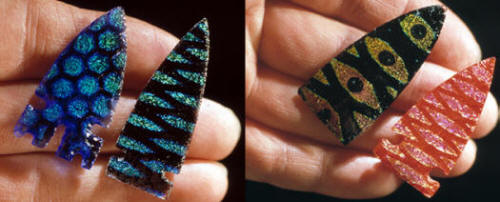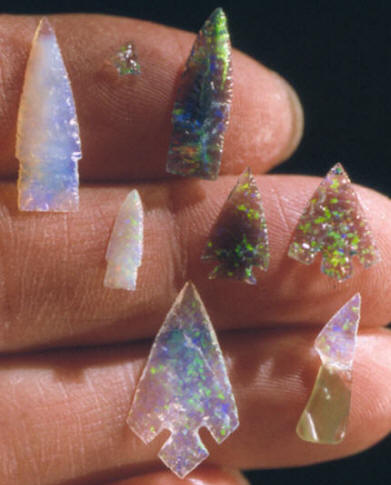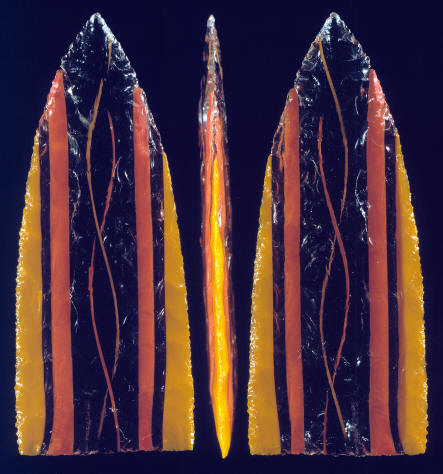|
James Howell started flintknapping about twelve years ago in 1995.
His first exposure to flintknapping was from Ron Fuller who was giving a
demonstration at a local flea market. James learned the basic techniques
from Ron Fuller and D.C. Waldorf's book on flintknapping. |
|

GLASS POINTS
BY JAMES HOWELL
JAMES HOWELL COLLECTION
These four beautiful points were made from different types of glass.
The two points on the left were made from different colored Venetian
glass that was laid onto clear glass. The center bands were made
from glass rods that were twisted. The banded and sparkly point in
the picture to the right was made from dichroic glass that is coated
with a metal oxide coating. The point on the far right was made from
millefiori Venetian glass
beads that have been melted together. |
|
|
James began to make glass points about six years ago in 2001.
That's when he began to experiment with many different types of glass
that he melts together in thin blanks in a kiln. His points reflect the
seemingly endless patterns of color that can be produced with this
technique. |
|

GLASS POINTS
BY JAMES HOWELL
JAMES HOWELL COLLECTION
All four of these points were made from dichroic glass that has a
metal oxide coating. This material comes in a variety of different
colors and patterns. |
|
|
James attends six or eight knap-ins a year. According to Dane
Martin, who is co-editor for "Chips," James is "the best source for
glass blanks for knapping in the world." Most of what he sells are the
blanks. He keeps most of his points but has sold a few. |
|

MINIATURE GLASS POINTS
BY JAMES HOWELL
JAMES HOWELL COLLECTION
These seven miniature points and one tiny hafted knife were all made
by James Howell. They were made from natural and man-made opal. The
four lighter colored points and knife are made of Australian fire
opal and the other four are made of man-made Gilson opal. The
smallest point at the top center measures 3/16 of an inch (4 mm)
long. |
|
|
Australia and North America are two areas where glass was used by
the indigenous people as soon as the first Europeans arrived with
bottles and telegraph insulators. In Australia, glass was used to make
Kimberly spear points. In California, the material was used to make
side-notched arrow points. |
|

CLICK ON PICTURE FOR LARGER IMAGE
GLASS POINT
BY JAMES HOWELL
JAMES HOWELL COLLECTION
This colorful point was made from yellow, orange, black and clear
glass. The twisting effect in the center is formed from a glass rod
that has been heated and twisted before merging the various pieces
together in the kiln. This point measures 2 1/4 inches (5.7 cm)
long. |
|
|
James Howell's points are exceptionally beautiful. They represent a new
direction for flintknapping. Heat treating stone can
change and enhance the color. But to be able to manufacture and control
both the pattern and color, that's new territory that's limited only by
the imagination. |
|
"REFERENCES"
1994,
Whittaker, John C., "Flintknapping, Making and Understanding Stone
Tools,"
p. 67.
2007, Personal communications with Russ Franks.
2007, Personal communications with Dane Martin, co-editor of
"Chips, The Flintknapper's Publication."
2007, Personal communications with D.C. Waldorf, senior editor of
"Chips, The Flintknapper's Publication."
|
|
RECENT
LISTINGS HOME
ORDERING |




